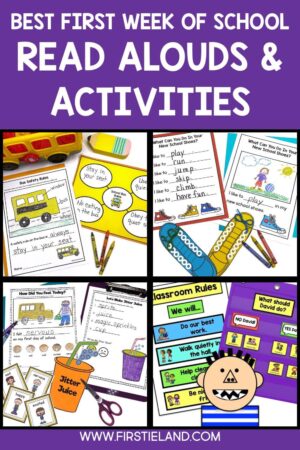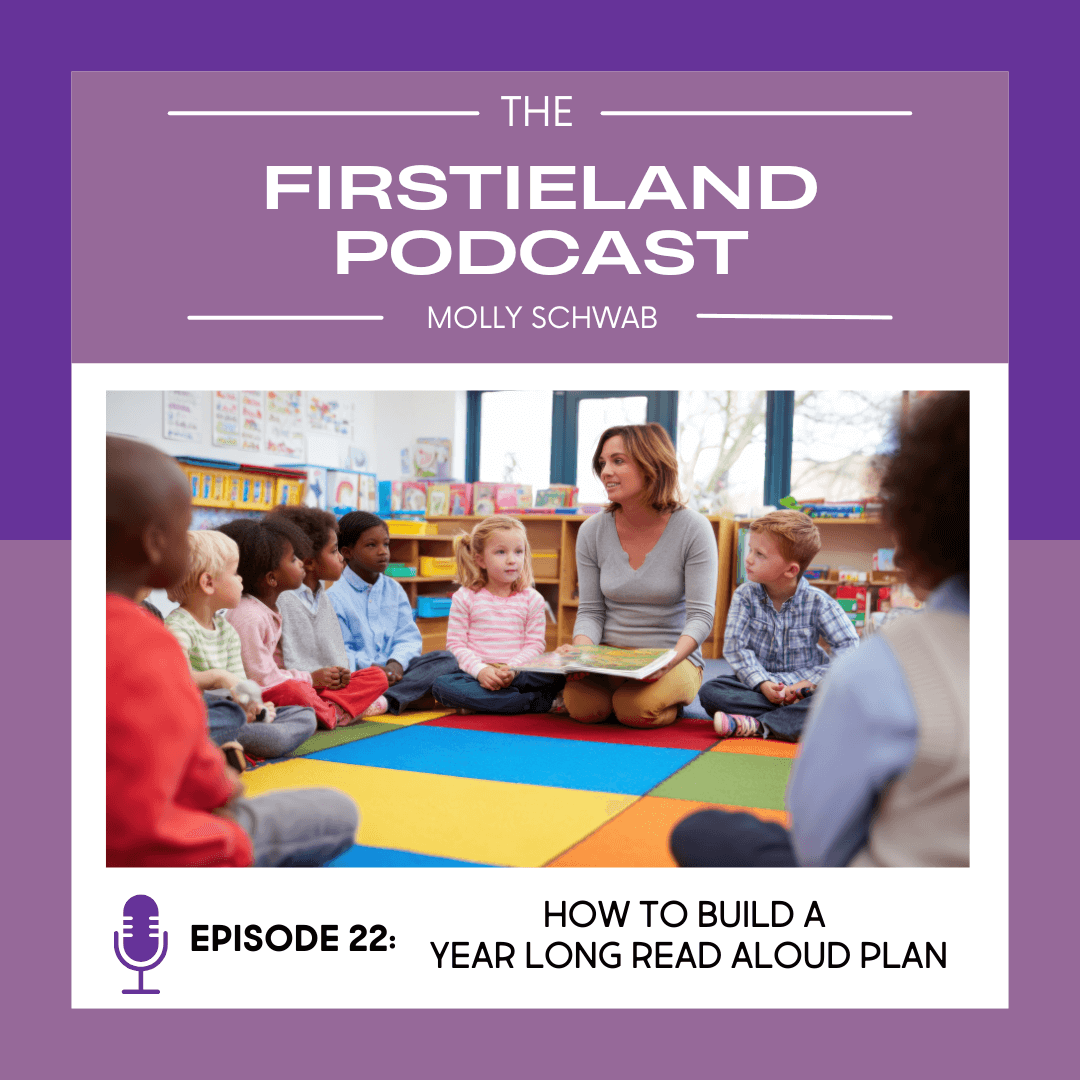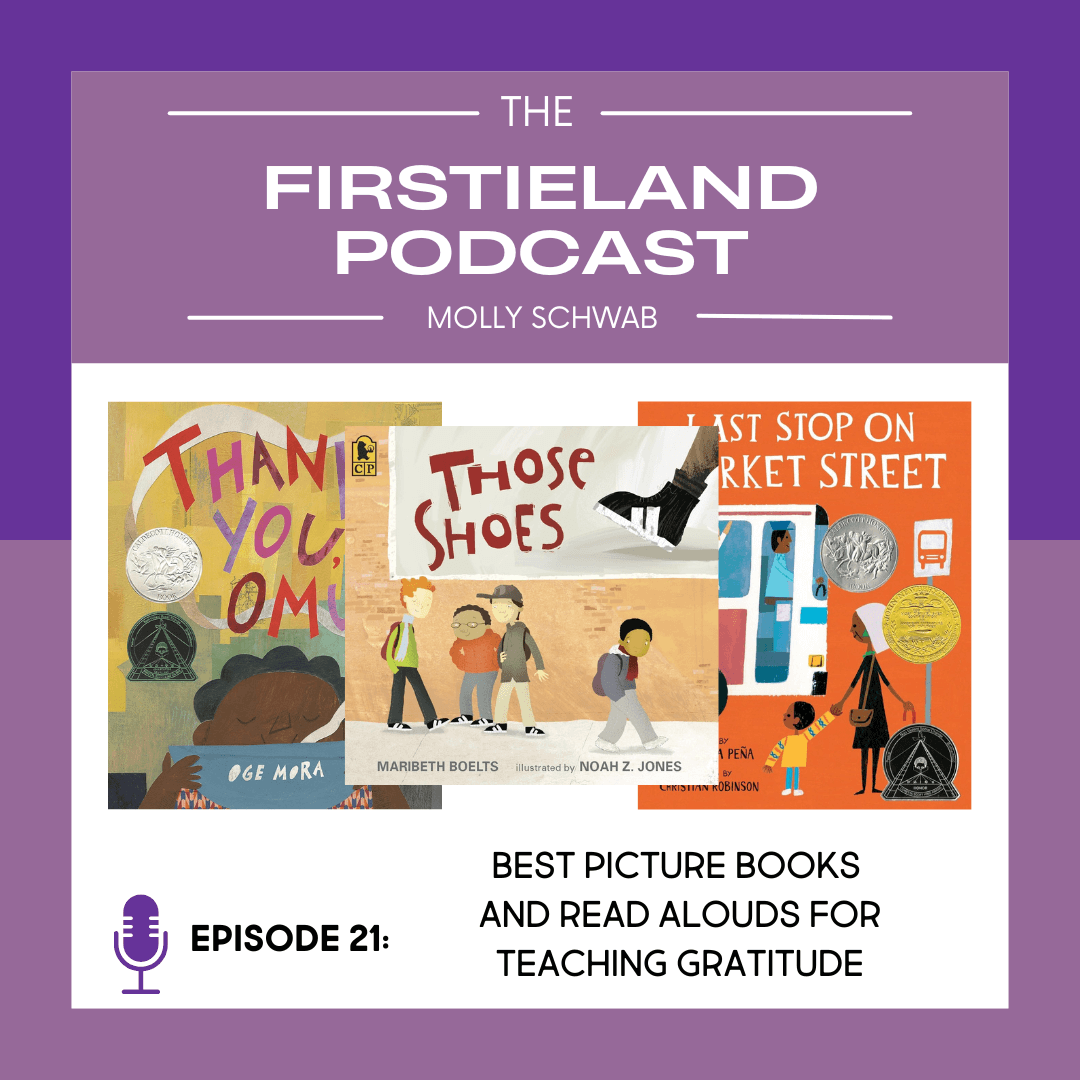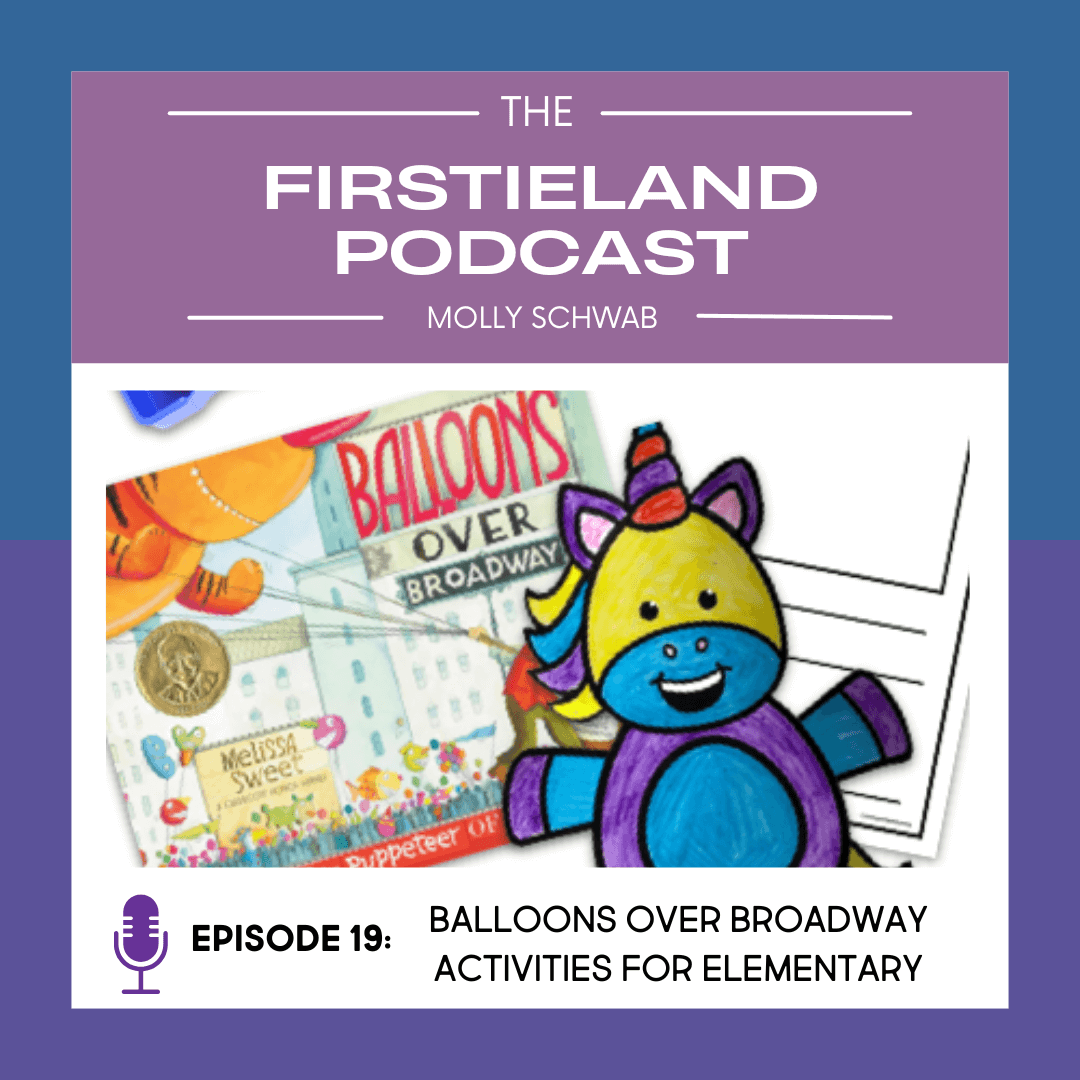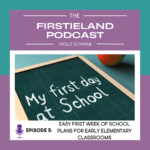[00:02:00]
Okay, so on the first day of school, when you have your kids coming into class, you are going to wanna have things planned that are very easy and quick for the first day of school. No long lessons where they have to sit for long periods of time because they have to build their stamina for being able to do that.
So I think that the activities that you plan should be short. Easy to do and then take a little break in between each activity. So my very favorite read aloud for the first day of school is called First Aid Jitters by Julie Danburg. It’s a cute book about a person who is very reluctant to go to school.
On the first day, they don’t wanna get out of bed. They don’t wanna eat their breakfast, they don’t wanna get in the car. And [00:03:00] then at the end of the story, you find out that the person who was nervous about coming to school was actually the teacher. So it’s a really cute book to talk about how everybody feels nervous about coming to school on the very first day and then after.
You read the story, what we did in my class, I gave the kids each a little strip of paper that had some little faces with different emotions, happy, sad, scared, nervous, and they could color the one that they were feeling and cut it out. And then they brought it up to the board and we made a little class graph, , about how we felt coming to school.
So it was a great way to start those conversations about how we’re feeling and as everybody. Okay with being here and that sort of thing, but there’s always a few that are nervous and so. I would always say, oh my, there’s some kids that are really nervous about being here. I think we should do something about that.
Let’s make some jitter juice to take away our jitters. [00:04:00] And so I’d have everybody gather around and we would make jitter juice together. And all jitter juice was. Was
hawaiian Punch and some Sprite, and then you have to have the magic ingredient, which are the anti jitterbugs. That’s what takes the jitters away. And anti jitterbugs are candy sprinkles. And I would put those little candy sprinkles that you would maybe sprinkle on cupcakes. I’d put a little label on it that said anti jitterbugs, and we would shake that in when we were making our jitter juice and then stir it up and the kids would all have some.
And sure enough, it took everybody’s jitters away. So that’s a really cute activity for the first day of school, and the kids enjoy doing it. And then after that, what you can do. Is have everybody come to the carpet and you can do a little interactive writing activity. Interactive writing is when you and the students share the pen to make some kind of an anchor chart.
And so in this case, we would write a list of the ingredients for jitter juice. And the reason I [00:05:00] always liked doing that on the first day of school was because. It showed me a lot about the kids in my class. It showed me who was willing to raise their hand to come up and help me write on the anchor chart who was shy and didn’t wanna be called on.
It also showed me who knew how to spell some words, who knew how to make the letters correctly, all of that kind of stuff. And so we would make a little list of the ingredients for jitter juice, and I’d call two or three kids up to help me write the words on that chart. And then when we were finished with that, we would do a little writing activity about how they felt on the first day of school.
And it was a simple template where they just had to fill in the word, , whether they felt nervous or scared or happy or sad or excited or whatever it was. And then they would draw a little picture to go with it. It was a very simple. Writing template because it’s the first day of school and then we made a little jitter juice craft.
So it’s just a few activities for the first day of [00:06:00] school. But really shows you a lot. It will show you, who can hold a pencil, who can write some words, who can write some letters,, who can cut with scissors, all those kinds of things. You’re gonna get your eye on all of that on the first day with these activities.
Alright, on the second day of school, now it’s time to really start building your classroom community. We would read the book Stick in Stone by Beth Ferry, which is a really cute book about a little stick and a little stone who are best friends and they help each other out in sticky situations. And when a bully comes along, they stick up for each other.
And it’s just a story about kindness and sticking together. And so after we read the story. I had a basket of sticks and kind of large stones, maybe at least the size of a quarter or half dollar, and I would number them. You wanna have enough sticks and stones for the amount of kids that are in your classroom.
For instance, if you have 20 [00:07:00] kids in your room, you’re gonna need 10 sticks and you’re gonna need 10 stones. And then I would number the sticks. One through 10 and the stones one through 10. And then the kids would have to find their partner that had the matching number, the sticks and the stones, and then they would partner up
and then they would work together all day to visit some friendship stations. So what you can do is set up four little friendship stations around your room for the kids to travel around to, and they will do the activities together with their new friend. So it’s a great way. For kids to make a friend. A lot of kids are gonna come to school and they’re not gonna have a friend, and they worry about that if they don’t have anybody to play with.
But once they do this activity, they know at least one person, somebody that they can sit with at lunch, somebody that they can play with on the playground. So the four friendship stations, very simple things that anybody can do. Kindergarten or first grade, early in the year. [00:08:00] Painting Kindness Rocks. I would just get some sort of large flat rocks.
You can find them at Michael’s or Hobby Lobby. They sell them in bags and I would just put some paint out and the kids could paint the kindness rocks and maybe put smiles on them or hearts or whatever. And then after they dried, later in the afternoon, we would hide the kindness rocks on the playground for other kids to find.
At station number two, the kids would play a friendship memory game. And it was just a simple game that had pictures of kids doing things together, playing on the playground, eating lunch, reading books, whatever it was. At the third station, they made friendship bracelets. Which were just a simple strip of paper that said things like, friends stick together and they could color the friendship bracelet, and then they would help each other tape it on their partner’s wrist.
So they had a friendship bracelet. Then the last station was a find a Friend activity where [00:09:00] they had a little worksheet that had all kinds of different things on it that you might like to do. Stuff like watch tv, ride your bike, , different foods you might like, pizza or ice cream. It was filled with different things and they would walk around and find friends who.
Liked the same things that they did, and they would check them off on their paper. So that would usually take most of the morning to visit those friendship stations. And then at the end of the day, we’d make friendship soup. And so in order to make friendship soup, you need seven different ingredients for the soup.
I liked using cereal, dry cereal, or you could use candy. Really anything that the kids would like to eat. , Nothing wet, you know, it has to be dry, just something simple. Cereal worked great. And so each ingredient was in its own bowl and it was labeled with a letter, and the first ingredient was labeled with an F for friendship.
And we would add that to a great big bowl and we would talk about how we all needed to be friends in our classroom. And then the next ingredient was labeled [00:10:00] R for respect. And we talked about how we needed to respect each other and the teacher, and we went through each ingredient. And spelled out the word friends.
By the time we were finished, each ingredient had the letters F-R-I-E-N-D-S. And so we mixed it all together and then they would eat that and we would talk about, this was our friendship soup, and now we all have a friend in the classroom and we’re gonna respect each other and that type of thing. So that was how we would spend day number two with the story stick in stone.
On day three, my favorite book to read is David Goes To School by David Shannon, because this is the day that is a good time to start writing your classroom rules. And if you’ve read the story, David goes to school. You know that David gets in lots of trouble and mischief at school, and he pretty much does everything he’s not supposed to do.
So the kids think it’s funny and it’s a good story to read when you’re talking about. Behaviors in the classroom and your [00:11:00] expectations. We would do a shared writing activity on this day as well, and we would create an anchor chart that we called our class, no-nos, and we would list some of the things that we should not do in school, no running, no hitting, that type of thing.
And then we would make a little David Craft and we would hang it with the chart out in the hallway or in our classroom to remind us of what we should do. And then later on, I usually would. Write another classroom rules chart written in more positive language, like instead of no hitting, it would be something like, we will keep our hands to ourself,
And then one other tip, we used to watch a video. It was a Minions video on YouTube about classroom rules. Very funny. And it’s really a cute video to watch when you’re writing your rules with your kids. So I’ll put a link to that in the show notes so you can find that easily. Okay, on day four, the fourth day of the week, now we’re gonna talk a little bit about school bus safety, [00:12:00] because probably most of your kids ride the bus.
And so my favorite book to read is 10 Rules. You absolutely must Not Break if you want to survive the School Bus. That’s a mouthful. I know it’s by John Grande, and it’s a funny book about a little boy who’s going to ride the school bus for the very first time, and he has an older brother who tells him all the things you should not do on the school bus.
And then of course the little boy. Makes mistakes over and over, and he does all the things he’s not supposed to do. So it’s a cute book to talk about bus safety. And so after we would read that story, , we would make a little chart, , about bus safety rules and we would talk about what you should do on the bus and how to be safe and then.
The kids would pick their favorite rule or one of the rules that they were definitely going to follow on the bus, and they would write a little sentence about it and they would draw a picture. And then finally at the end, we would make a school bus [00:13:00] craft. And the craft that we made was all shapes. It was like rectangles, circles, squares, triangles.
And so it was a good, , way to find out if the kids knew their shapes and. Check those fine motor skills, who can cut with scissors, who can glue, that type of thing. So I liked doing that on day four for making, , school bus safety rules. And then finally on Friday, we would repeat the cat rocking in my new school shoes by James Dean.
And this is just a super cute book. You probably know the book already. And if you don’t, Pete the cat is great. Kids just love him and we would. Use this book because lots of kids have brand new school shoes on. And so we wrote about what we could do in our new school shoes. And so we would make a big anchor chart where the kids would help me write it, and we would make a class list of all the things that you could do in your new school shoes.
You know, you can run, you can jump, , you can play all those kinds of things. And then the kids would. [00:14:00] Do a little writing activity. , Again, a very simple template where they just had to fill in one or two words and draw a picture, , about what they could do in their new school shoes. And then they made a little shoe craft, , that was cute to put with their writing.
And by the end of the week, doing all these little crafts and writing activities, I had plenty of stuff to hang on my bulletin boards and display in the hallway. And I had been able to check so many things just through these simple activities. , You can check, , their fine motor skills and who’s able to hold a pencil and who knows some of their letters and who can write some words, and all those kinds of things you’re finding out in these activities that are quick and easy for the first week of school.
All right, friend. That’s a wrap on the first week of school activities. I hope these ideas help you feel a little bit more prepared and give you some fun ways to start building routines and relationships with your class. And if you want everything in one place, all these read aloud [00:15:00] activities and writing templates and crafts. I have it put together for you in my first week of school bundle. It’s super easy to use, very low prep, ready to go. I’ll drop the link in the show notes along with links to all the books and everything else that I mentioned today.
Alrighty. Thanks for spending some time with me, and as always, remember to make learning feel like play. See you next time.
